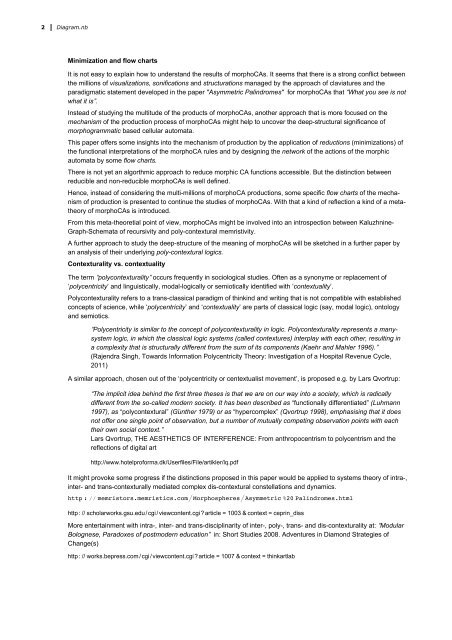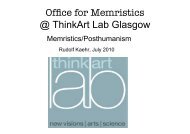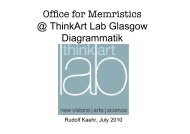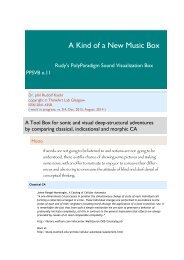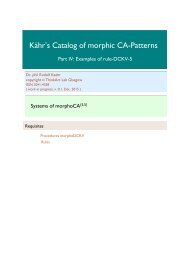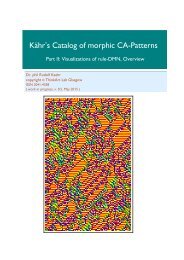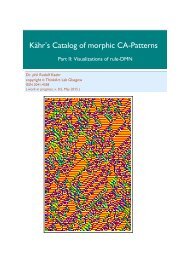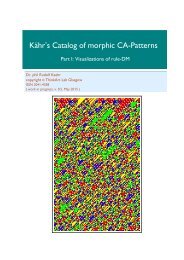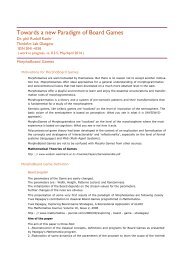Metaphors of Dissemination and Interaction of morphoCAs
Meta-theoretical considerations about the behavior of morphic cellular automata are sketched. Different types of flow diagrams for morphoCAs are distinguished: 1. mono-contextural, 2. interactional/transactional and 3. mediational poly-contextural types. Those thematizations are offering a better understanding of the nature of morphic cellular automata.
Meta-theoretical considerations about the behavior of morphic cellular automata are sketched. Different types of flow diagrams for morphoCAs are distinguished: 1. mono-contextural, 2. interactional/transactional and 3. mediational poly-contextural types. Those thematizations are offering a better understanding of the nature of morphic cellular automata.
Create successful ePaper yourself
Turn your PDF publications into a flip-book with our unique Google optimized e-Paper software.
2 Diagram.nb<br />
Minimization <strong>and</strong> flow charts<br />
It is not easy to explain how to underst<strong>and</strong> the results <strong>of</strong> <strong>morphoCAs</strong>. It seems that there is a strong conflict between<br />
the millions <strong>of</strong> visualizations, sonifications <strong>and</strong> structurations managed by the approach <strong>of</strong> claviatures <strong>and</strong> the<br />
paradigmatic statement developed in the paper "Asymmetric Palindromes" for <strong>morphoCAs</strong> that “What you see is not<br />
what it is”.<br />
Instead <strong>of</strong> studying the multitude <strong>of</strong> the products <strong>of</strong> <strong>morphoCAs</strong>, another approach that is more focused on the<br />
mechanism <strong>of</strong> the production process <strong>of</strong> <strong>morphoCAs</strong> might help to uncover the deep-structural significance <strong>of</strong><br />
morphogrammatic based cellular automata.<br />
This paper <strong>of</strong>fers some insights into the mechanism <strong>of</strong> production by the application <strong>of</strong> reductions (minimizations) <strong>of</strong><br />
the functional interpretations <strong>of</strong> the morphoCA rules <strong>and</strong> by designing the network <strong>of</strong> the actions <strong>of</strong> the morphic<br />
automata by some flow charts.<br />
There is not yet an algorthmic approach to reduce morphic CA functions accessible. But the distinction between<br />
reducible <strong>and</strong> non-reducible <strong>morphoCAs</strong> is well defined.<br />
Hence, instead <strong>of</strong> considering the multi-millions <strong>of</strong> morphoCA productions, some specific flow charts <strong>of</strong> the mechanism<br />
<strong>of</strong> production is presented to continue the studies <strong>of</strong> <strong>morphoCAs</strong>. With that a kind <strong>of</strong> reflection a kind <strong>of</strong> a metatheory<br />
<strong>of</strong> <strong>morphoCAs</strong> is introduced.<br />
From this meta-theoretial point <strong>of</strong> view, <strong>morphoCAs</strong> might be involved into an introspection between Kaluzhnine-<br />
Graph-Schemata <strong>of</strong> recursivity <strong>and</strong> poly-contextural memristivity.<br />
A further approach to study the deep-structure <strong>of</strong> the meaning <strong>of</strong> <strong>morphoCAs</strong> will be sketched in a further paper by<br />
an analysis <strong>of</strong> their underlying poly-contextural logics.<br />
Contexturality vs. contextuality<br />
The term “polycontexturality” occurs frequently in sociological studies. Often as a synonyme or replacement <strong>of</strong><br />
‘polycentricity’ <strong>and</strong> linguistically, modal-logically or semiotically identified with ‘contextuality’.<br />
Polycontexturality refers to a trans-classical paradigm <strong>of</strong> thinkind <strong>and</strong> writing that is not compatible with established<br />
concepts <strong>of</strong> science, while ‘polycentricity’ <strong>and</strong> ‘contextuality’ are parts <strong>of</strong> classical logic (say, modal logic), ontology<br />
<strong>and</strong> semiotics.<br />
“Polycentricity is similar to the concept <strong>of</strong> polycontexturality in logic. Polycontexturality represents a manysystem<br />
logic, in which the classical logic systems (called contextures) interplay with each other, resulting in<br />
a complexity that is structurally different from the sum <strong>of</strong> its components (Kaehr <strong>and</strong> Mahler 1996).”<br />
(Rajendra Singh, Towards Information Polycentricity Theory: Investigation <strong>of</strong> a Hospital Revenue Cycle,<br />
2011)<br />
A similar approach, chosen out <strong>of</strong> the ‘polycentricity or centextualist movement’, is proposed e.g. by Lars Qvortrup:<br />
“The implicit idea behind the first three theses is that we are on our way into a society, which is radically<br />
different from the so-called modern society. It has been described as “functionally differentiated” (Luhmann<br />
1997), as “polycontextural” (Günther 1979) or as “hypercomplex” (Qvortrup 1998), emphasising that it does<br />
not <strong>of</strong>fer one single point <strong>of</strong> observation, but a number <strong>of</strong> mutually competing observation points with each<br />
their own social context.”<br />
Lars Qvortrup, THE AESTHETICS OF INTERFERENCE: From anthropocentrism to polycentrism <strong>and</strong> the<br />
reflections <strong>of</strong> digital art<br />
http://www.hotelpr<strong>of</strong>orma.dk/Userfiles/File/artikler/lq.pdf<br />
It might provoke some progress if the distinctions proposed in this paper would be applied to systems theory <strong>of</strong> intra-,<br />
inter- <strong>and</strong> trans-contexturally mediated complex dis-contextural constellations <strong>and</strong> dynamics.<br />
http : // memristors.memristics.com Morphospheres Asymmetric %20 Palindromes.html<br />
http : // scholarworks.gsu.edu / cgi / viewcontent.cgi ? article = 1003 & context = ceprin_diss<br />
More entertainment with intra-, inter- <strong>and</strong> trans-disciplinarity <strong>of</strong> inter-, poly-, trans- <strong>and</strong> dis-contexturality at: “Modular<br />
Bolognese, Paradoxes <strong>of</strong> postmodern education” in: Short Studies 2008. Adventures in Diamond Strategies <strong>of</strong><br />
Change(s)<br />
http : // works.bepress.com / cgi / viewcontent.cgi ? article = 1007 & context = thinkartlab<br />
Three kinds <strong>of</strong> morphoCA diagrams


